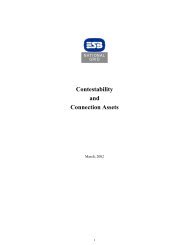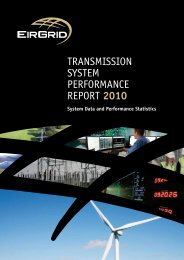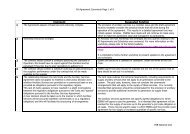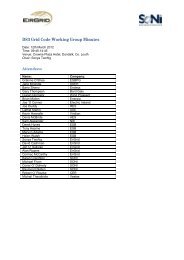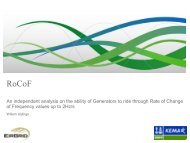Winter Outlook 2010-2011 - Eirgrid
Winter Outlook 2010-2011 - Eirgrid
Winter Outlook 2010-2011 - Eirgrid
Create successful ePaper yourself
Turn your PDF publications into a flip-book with our unique Google optimized e-Paper software.
<strong>Winter</strong> <strong>Outlook</strong><strong>2010</strong>-<strong>2011</strong>SummaryThis <strong>Winter</strong> <strong>Outlook</strong> report examines the capability of thegeneration portfolio available to EirGrid and SONI to meet peakdemands in Ireland and Northern Ireland between November <strong>2010</strong>and March <strong>2011</strong> inclusive. For the first time ever, both jurisdictionswill be covered, examining the areas of growth in demand andthe capacity and performance of generation (both conventionaland wind). It also examines the available import capacity toNorthern Ireland via the Moyle interconnector from Scotland.Both deterministic and probabilistic analyses were carried out.The expected outlook is that there should be sufficient capacityfor the winter period to ensure the appropriate level of securityof supply is maintained.Demand GrowthThere has been strong correlation between economic growth andgrowth in electricity demand, particularly in recent times. Thedownturn in the economy that began in 2008, and continuedthroughout last year, resulted in a reduction in electricity demand.Chart 1 – 3-month Rolling Electricity Growth June 2008 to dateChart 2 below shows the overall peak demands for each yearfrom 2001 to <strong>2010</strong>. The annual peak demand is dependent onweather and other factors, including the recent underlying declinein overall growth in electricity demand. From 2001 to 2007, therewas an increase in peak electricity demands each year. However,since 2007, the growth in peaks has been negligible.Chart 1 shows the 3-month rolling electricity growth rate fromJanuary 2008 to May <strong>2010</strong>. As can be seen, the overall electricitygrowth rate fell during the second half of 2008 and the first halfof 2009. Since the start of <strong>2010</strong>, there has been an increase indemand which can be attributed (in part) to the extreme coldweather conditions experienced during the first quarter of <strong>2010</strong>. Chart 2 – Historical Peaks from 2001 to <strong>2010</strong>
<strong>Winter</strong> <strong>Outlook</strong><strong>2010</strong>-<strong>2011</strong><strong>Winter</strong> Daily Demand ProfileChart 3 shows a typical winter’s day demand profile. Whilstthe lowest demand period for both jurisdictions is usually coincidental,the peak demand in Northern Ireland usually occurs15-30 minutes before the peak in Ireland. The graph shows thetypical shape of the demand curve throughout the winter period,with two major demand increases occurring from 06:00 to 08:00and again from 16:00 to 18:00Chart 3 – Demand Profile Wednesday 20 th January <strong>2010</strong>Peak DemandDuring the 2009/<strong>2010</strong> winter period, the peak demand forelectricity in Ireland was 4,950 MW. This occurred on Thursday7 th January <strong>2010</strong>. This represented an unexpected increase onthe previous year’s peak, which can be attributed to the extremeweather conditions during last winter. In Northern Ireland, thepeak demand for electricity during the 2009/<strong>2010</strong> winter periodwas 1,745 MW. This occurred on Tuesday 12 th January <strong>2010</strong>. Thisyear, considering all factors, it is expected that the overall peakdemand across both jurisdictions will be 6,440 MW.Installed Capacity & GenerationUnit PerformanceEirGrid and SONI met with all conventional generators anddiscussed the general condition of the units and the expectedperformance of the units over the winter period, includingcommissioning of new plant, outages and de-ratings of plant.Based on these discussions, it is assumed that:• The installed capacity of conventional, dispatchable generationin Northern Ireland will be 2,286 MW, not including the MoyleInterconnector.• The import capacity of the Moyle Interconnector to NorthernIreland during winter is 450 MW.The installed capacity figures do not allow for any forced outageswhich could be expected in the winter period.Generation Unit PerformanceChart 4 shows the Weekly Forced Outage Rate and the 52-weekRolling Average Forced Outage Rate from January 2009 to date.As can been seen, Weekly Forced Outage Rates can vary sharplyon a week-to-week basis. However, the general trend is animprovement in the performance of the plant portfolio and areduction in forced outage rates.Chart 4 – Weekly FOR & 52-week Rolling Average FOR 2009to <strong>2010</strong>The Forced Outage Probabilities for the analysis are based on thepast performance of the generation units and the discussionswith the plant operators. The overall Forced Outage Probabilityfor the analysis is 8%.Wind GenerationTable 1 below shows a summary of the key wind statistics forIreland and Northern Ireland during last winter.IrelandNorthern IrelandInstalled Wind Capacity 1,175 MW 301 MW• The installed capacity of conventional, dispatchablegeneration in Ireland will be 6,792 MW. This figure includesWhitegate CCGT and Edenderry Peakers, which are expectedto become commercially available before the winter period.Highest Wind Outputat Daily PeakAverage Wind Contributionat Daily Peak1,069 MW 273 MW328 MW 81 MWTable 1 – Summary of Wind Statistics for last winter period.
<strong>Winter</strong> <strong>Outlook</strong><strong>2010</strong>-<strong>2011</strong>Chart 5 below shows the overall wind generation at the timeof peak demand each day during the winter period. There issignificant variance on a day-to-day basis.EirGrid is building further interconnection between Ireland andBritain. The link, known as the East-West Interconnector, is beingbuilt between Woodland, Co. Meath in Ireland and Deeside innorth Wales in Britain. It is on target for commissioning in 2012.Chart 5 – Wind generation at the time of overall peak demandThere is currently 1,740 MW of wind capacity connected and itis expected that an additional 350 - 450 MW will connect up tothe end of March <strong>2011</strong>. For analysis purposes, an overall windcapacity credit of 360 MW is assumed for this winter.InterconnectionThe Moyle Interconnector links the electricity grids of NorthernIreland and Scotland through HVDC undersea cables runningbetween converter stations at Ballycronan More in Islandmagee,Co. Antrim and Auchencrosh, Ayrshire, Scotland. The totalinstalled capacity of the link is 500 MW but the transfercapability is curtailed by certain network limitations on bothsides. The available Net Transfer Capacity (NTC) from Scotlandto Northern Ireland is 450 MW during the winter and 410 MWfrom April to October inclusive. The Net Transfer Capacity fromNorthern Ireland to Scotland is 80 MW.The Moyle Interconnector has enhanced the security of electricitysupply in Northern Ireland and Ireland. It enables trading withthe wholesale electricity market in Britain. For the purpose ofthis analysis, it is assumed that Moyle Interconnector has aForced Outage Probability of 0.2%.Key Developments Over 2009-10• Aghada Unit 2, a 432 MW gas-fired CCGT unit, becamecommercially available on 31 st March <strong>2010</strong>.• Whitegate CCGT, a 445 MW gas-fired CCGT unit, is expected tocomplete commissioning and become commercially availableby October <strong>2010</strong>.• Edenderry Peakers, 2 open-cycle distillate peaking units witha total generating capacity of 114 MW, are expected to becommercially available before the start of the winter period.• There is not expected to be any generating units eithercommissioned or decommissioned in Northern Ireland beforethe end of the winter <strong>2010</strong>/11 period.• The Generating Unit Agreements for the coal/oil fired KilrootGenerating Units No. 1 and No. 2 will be cancelled on 1stNovember <strong>2010</strong>. At this point they will become IndependentPower Producers. This will affect the declared capacitiesavailable, but only by a few MW.• Poolbeg Units 1, 2 and 3 were decommissioned on 31 st March<strong>2010</strong>. The steam turbine in Marina was also decommissionedand Marina is now operating as an open-cycle gas turbine.The total decommissioned generation was 497 MW.• Overall, there is expected to be an increase of 350-450 MWof wind generation connecting to both systems. This willresult in an increase in the wind capacity credit to 360 MW.• Given the extreme weather event last winter, the forecastedpeak this winter is not expected to exceed last winter’speak.Expected <strong>Outlook</strong>Deterministic AnalysisDeterministic analysis was carried out to examine the ability tomeet peak demands over the winter period. The analysis showsthat there should be sufficient generation capacity this winterto meet peak demands and reserve requirements and that theappropriate level of security of supply should be maintainedthroughout the winter period.Chart 6 shows that the expected overall margin during the weekwhere the peak demand occurs is over 2,600 MW. This overallmargin includes the available generation capacity (taking intoaccount forced outage probabilities), the wind capacity credit andthe imports from Scotland via the Moyle Interconnector assumingthat the capacity is available from Britain (National Grid).
<strong>Winter</strong> <strong>Outlook</strong><strong>2010</strong>-<strong>2011</strong> Chart 6 – Expected Overall Margin during Peak Demand WeekNorth-South Tie-LineThe ability to exchange power over the North-South tie-linesbetween the Ireland transmission system and the NorthernIreland transmission system is an important feature of the SingleElectricity Market (SEM). The level of import/export available atany point in time is dependent on the generation availabilityin Ireland and Northern Ireland, the status of the Moyleinterconnector (from Northern Ireland to Scotland), the statusof the transmission network on both the Ireland and NorthernIreland systems and operating reserve requirements.Probabilistic AnalysisThe generation capacity adequacy standard is based on aprobabilistic analysis (see box) and is defined as a Loss of LoadExpectation (LOLE) of 8 hours per year for Ireland and 4.9 hoursper year for Northern Ireland. The results of the probabilisticanalysis for the expected scenario indicated that both systemsremain well within the capacity adequacy standard.Expected outlookConsidering all the factors, it is expected the capacity marginsacross both jurisdictions will be sufficient to maintain securityof supply standards. Interconnection with Scotland will remainan important feature of the SEM and the demand/supplybalance. Wind is expected to make a contribution in line with itscapacity credit. This outlook is an improvement from previousyears, primarily due to the drop in demand in both jurisdictionsand also due to the commissioning of new plants at Aghada,Edenderry and Whitegate.ConclusionThe outlook for the winter period is that the generation capacitywill be sufficient this winter to ensure the appropriate levelof security of supply standards is maintained in Ireland andNorthern Ireland. EirGrid and SONI will continue to manageand monitor the system carefully and to keep all stakeholdersupdated.HOW TO CONTACT USEirGridTel: +353 1 7026642Email: info@eirgrid.comOn the web @www.eirgrid.comSONITel: +44 28 90794336Email: enquiries@soni.ltd.ukOn the web @www.soni.ltd.ukDisclaimer:While every effort has been made in the compilation ofthis <strong>Winter</strong> <strong>Outlook</strong> report to ensure that the informationcontained herein is correct we cannot accept responsibilityor liability whatsoever for any damage howsoever causedby reliance on the information presented here.Chart 7 shows the LOLE and Capacity Margin for each weekduring the winter period.Chart 7 – <strong>Winter</strong> <strong>2010</strong>/11 LOLE and Capacity MarginGeneration Adequacy & Loss of Load ExpectationThe balance between the supply of electricity and thedemand is quantified using a statistical indicator called theloss of load expectation (LOLE). When this indicator is at anappropriate level, called the Generation Adequacy Standard,the supply/demand balance is judged to be satisfactory. Theaccepted generation adequacy for Ireland is 8 hours LOLEper year and 4.9 hours LOLE per year for Northern Ireland.



